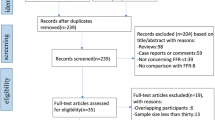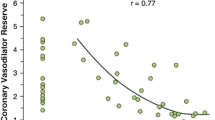Abstract
Background
Although absolute quantification of myocardial blood flow (MBF) by positron emission tomography provides additive diagnostic value to visual analysis of perfusion defect, diagnostic accuracy of different MBF parameters remain unclear.
Methods
Clinical studies regarding the diagnostic accuracy of hyperemic MBF (hMBF), myocardial flow reserve (MFR) and/or relative flow reserve (RFR) were searched and systematically reviewed. On a per-vessel basis, pooled measures of the parameters’ diagnostic performances were analyzed, regarding significant coronary stenosis defined by fractional flow reserve or diameter stenosis.
Results
Ten studies (2,522 arteries from 1,099 patients) were finally included. Pooled sensitivity [95% confidence interval (CI)] was 0.853 (0.821-0.881) for hMBF, 0.755 (0.713-0.794) for MFR, and 0.636 (0.539-0.726) for RFR. Pooled specificity (95% CI) was 0.844 (0.827-0.860) for hMBF, 0.804 (0.784-0.824) for MFR, and 0.897 (0.860-0.926) for RFR. Pooled area under the curve ± standard error was 0.900 ± 0.020 for hMBF, 0.830 ± 0.026 for MFR, and 0.873 ± 0.048 for RFR.
Conclusions
hMBF showed the best sensitivity while RFR showed the best specificity in the diagnosis of significant coronary stenosis. MFR was less sensitive than hMBF and less specific than hMBF and RFR.





Similar content being viewed by others
Abbreviations
- PET:
-
Positron emission tomography
- CAD:
-
Coronary artery disease
- MBF:
-
Myocardial blood flow
- hMBF:
-
Hyperemic myocardial blood flow
- RFR:
-
Relative flow reserve
- SPECT:
-
Single-photon emission computed tomography
- DS:
-
Diameter stenosis
- Ado:
-
Adenosine
- Reg:
-
Regadenoson
References
Ghotbi AA, Kjaer A, Hasbak P. Review: Comparison of PET rubidium-82 with conventional SPECT myocardial perfusion imaging. Clin Phys Funct Imaging 2014;34:163-70.
Driessen RS, Raijmakers PG, Stuijfzand WJ, Knaapen P. Myocardial perfusion imaging with PET. Int J Cardiovasc Imaging 2017;33:1021-31.
Cremer P, Hachamovitch R, Tamarappoo B. Clinical decision making with myocardial perfusion imaging in patients with known or suspected coronary artery disease. Semin Nucl Med 2014;44:320-9.
Herzog BA, Husmann L, Valenta I, Gaemperli O, Siegrist PT, Tay FM, Burkhard N, Wyss CA, Kaufmann PA. Long-term prognostic value of 13N-ammonia myocardial perfusion positron emission tomography added value of coronary flow reserve. J Am Coll Cardiol 2009;54:150-6.
Taqueti VR, Hachamovitch R, Murthy VL, Naya M, Foster CR, Hainer J, Dorbala S, Blankstein R, Di Carli MF. Global coronary flow reserve is associated with adverse cardiovascular events independently of luminal angiographic severity and modifies the effect of early revascularization. Circulation 2015;131:19-27.
Gupta A, Taqueti VR, van de Hoef TP, Bajaj NS, Bravo PE, Murthy VL, Osborne MT, Seidelmann SB, Vita T, Bibbo CF, Harrington M, Hainer J, Rimoldi O, Dorbala S, Bhatt DL, Blankstein R, Camici PG, Di Carli MF. Integrated noninvasive physiological assessment of coronary circulatory function and impact on cardiovascular mortality in patients with stable coronary artery disease. Circulation 2017;136:2325-36.
Cho SG, Kim HS, Bom HHS. Flow-based functional assessment of coronary artery disease by myocardial perfusion positron emission tomography in the era of fractional flow reserve. Ann Nucl Cardiol 2016;2:99-105.
Ziadi MC. Myocardial flow reserve (MFR) with positron emission tomography (PET)/computed tomography (CT): Clinical impact in diagnosis and prognosis. Cardiovasc Diagn Ther 2017;7:206-18.
Johnson NP, Kirkeeide RL, Gould KL. Is discordance of coronary flow reserve and fractional flow reserve due to methodology or clinically relevant coronary pathophysiology? J Am Coll Cardiol Cardiovasc Imaging 2012;5:193-202.
Cho SG, Park KS, Kim J, Kang SR, Song HC, Kim JH, Cho JY, Hong YJ, Jabin Z, Park HJ, Jeong GC, Kwon SY, Paeng JC, Kim HS, Min JJ, Garcia EV, Bom HHS. Coronary flow reserve and relative flow reserve measured by N-13 ammonia PET for characterization of coronary artery disease. Ann Nucl Med 2017;31:144-52.
Whiting PF, Rutjes AW, Westwood ME, Mallett S, Deeks JJ, Reitsma JB, Leeflang MM, Sterne JA, Bossuyt PM, QUADAS-2 Group. QUADAS-2: A revised tool for the quality assessment of diagnostic accuracy studies. Ann Intern Med 2011;155:529-36.
Lee J, Kim KW, Choi SH, Huh J, Park SH. Systematic review and meta-analysis of studies evaluating diagnostic test accuracy: A practical review for clinical researchers—Part II. Statistical methods of meta-analysis. Korean J Radiol 2015;16:1188-96.
Zamora J, Abraira V, Muriel A, Khan K, Coomarasamy A. Meta-disc: A software for meta-analysis of test accuracy data. BMC Med Res Methodol 2006;6:31.
Egger M, Davey Smith G, Schneider M, Minder C. Bias in meta-analysis detected by a simple, graphical test. BMJ 1997;315:629-34.
Danad I, Raijmakers PG, Harms HJ, Heymans MW, van Royen N, Lubberink M, Boellaard R, van Rossum AC, Lammertsma AA, Knaapen P. Impact of anatomical and functional severity of coronary atherosclerotic plaques on the transmural perfusion gradient: A [15O]H2O PET study. Eur Heart J 2014;35:2094-105.
Danad I, Uusitalo V, Kero T, Saraste A, Raijmakers PG, Lammertsma AA, Heymans MW, Kajander SA, Pietilä M, James S, Sörensen J, Knaapen P, Knuuti J. Quantitative assessment of myocardial perfusion in the detection of significant coronary artery disease: Cutoff values and diagnostic accuracy of quantitative [15O]H2O PET imaging. J Am Coll Cardiol 2014;64:1464-75.
Hajjiri MM, Leavitt MB, Zheng H, Spooner AE, Fischman AJ, Gewirtz H. Comparison of positron emission tomography measurement of adenosine-stimulated absolute myocardial blood flow versus relative myocardial tracer content for physiological assessment of coronary artery stenosis severity and location. J Am Coll Cardiol Cardiovasc Imaging 2009;2:751-8.
Joutsiniemi E, Saraste A, Pietilä M, Mäki M, Kajander S, Ukkonen H, Airaksinen J, Knuuti J. Absolute flow or myocardial flow reserve for the detection of significant coronary artery disease? Eur Heart J Cardiovasc Imaging 2014;15:659-65.
Kajander SA, Joutsiniemi E, Saraste M, Pietilä M, Ukkonen H, Saraste A, Sipilä HT, Teräs M, Mäki M, Airaksinen J, Hartiala J, Knuuti J. Clinical value of absolute quantification of myocardial perfusion with 15O-water in coronary artery disease. Circ Cardiovasc Imaging 2011;4:678-84.
Lee JM, Kim CH, Koo BK, Hwang D, Park J, Zhang J, Tong Y, Jeon KH, Bang JI, Suh M, Paeng JC, Cheon GJ, Na SH, Ahn JM, Park SJ, Kim HS. Integrated myocardial perfusion imaging diagnostics improve detection of functionally significant coronary artery stenosis by 13N-ammonia positron emission tomography. Circ Cardiovasc Imaging 2016. https://doi.org/10.1161/circimaging.116.004768.
Peelukhana SV, Kerr H, Kolli KK, Fernandez-Ulloa M, Gerson M, Effat M, Arif I, Helmy T, Banerjee R. Benefit of cardiac N-13 PET CFR for combined anatomical and functional diagnosis of ischemic coronary artery disease: A pilot study. Ann Nucl Med 2014;28:746-60.
Stuijfzand WJ, Uusitalo V, Kero T, Danad I, Rijnierse MT, Saraste A, Raijmakers PG, Lammertsma AA, Harms HJ, Heymans MW, Huisman MC, Marques KM, Kajander SA, Pietilä M, Sörensen J, van Royen N, Knuuti J, Knaapen P. Relative flow reserve derived from quantitative perfusion imaging may not outperform stress myocardial blood flow for identification of hemodynamically significant coronary artery disease. Circ Cardiovasc Imaging 2015. https://doi.org/10.1161/circimaging.114.002400.
Thomassen A, Petersen H, Johansen A, Braad PE, Diederichsen AC, Mickley H, Jensen LO, Gerke O, Simonsen JA, Thayssen P, Høilund-Carlsen PF. Quantitative myocardial perfusion by O-15-water PET: Individualized vs. standardized vascular territories. Eur Heart J Cardiovasc Imaging 2015;16:970-6.
Dai N, Zhang X, Zhang Y, Hou L, Li W, Fan B, Zhang T, Xu Y. Enhanced diagnostic utility achieved by myocardial blood analysis: A meta-analysis of noninvasive cardiac imaging in the detection of functional coronary artery disease. Int J Cardiol 2016;221:665-73.
Lee JM, Layland J, Jung JH, Lee HJ, Echavarria-Pinto M, Watkins S, Yong AS, Doh JH, Nam CW, Shin ES, Koo BK, Ng MK, Escaned J, Fearon WF, Oldroyd KG. Integrated physiologic assessment of ischemic heart disease in real-world practice using index of microcirculatory resistance and fractional flow reserve: Insights from the International Index of Microcirculatory Resistance Registry. Circ Cardiovasc Interv 2015. https://doi.org/10.1161/circinterventions.115.002857.
Hwang D, Jeon KH, Lee JM, Park J, Kim CH, Tong Y, Zhang J, Bang JI, Suh M, Paeng JC, Na SH, Cheon GJ, Cook CM, Davies JE, Koo BK. Diagnostic performance of resting and hyperemic invasive physiological indices to define myocardial ischemia: Validation with 13N-ammonia positron emission tomography. JACC Cardiovasc Interv 2017;10:751-60.
Hsu B. PET tracers and techniques for measuring myocardial blood flow in patients with coronary artery disease. J Biomed Res 2013;27:452-9.
Nesterov SV, Deshayes E, Sciagra R, Settimo L, Declerck JM, Pan XB, Yoshinaga K, Katoh C, Slomka PJ, Germano G, Han CL, Aalto V, Alessio AM, Ficaro EP, Lee BC, Nekolla SG, Gwet KL, deKemp RA, Klein R, Dickson J, Case JA, Bateman T, Prior JO, Knuuti JM. Quantification of myocardial blood flow in absolute terms using Rb-82 PET imaging: Results of RUBY-10—A multicenter study comparing ten computer analysis programs. J Am Coll Cardiol Cardiovasc Imaging 2014;7:1119-27.
Disclosure
Henry Hee-Seung Bom receives research fund from the Basic Science Research Program through the National Research Foundation of Korea (NRF) funded by the Ministry of Education (NRF2016R1D1A3B01006631). Drs. Sang-Geon Cho, Soo Jin Lee, Myung Hwan Na, and Yun Young Choi declare no conflicts of interests.
Author information
Authors and Affiliations
Corresponding authors
Additional information
The authors of this article have provided a PowerPoint file, available for download at SpringerLink, which summarises the contents of the paper and is free for re-use at meetings and presentations. Search for the article DOI on SpringerLink.com.
Funding
This study was supported by a Grant (NRF-2016R1D1A3B01006631) of the Basic Science Research Program through the National Research Foundation (NRF) funded by the Ministry of Education, Republic of Korea.
All editorial decisions for this article, including selection of reviewers and the final decision, were made by guest editor Henry Gewirtz, MD.
Electronic supplementary material
Below is the link to the electronic supplementary material.
Rights and permissions
About this article
Cite this article
Cho, SG., Lee, S.J., Na, M.H. et al. Comparison of diagnostic accuracy of PET-derived myocardial blood flow parameters: A meta-analysis. J. Nucl. Cardiol. 27, 1955–1966 (2020). https://doi.org/10.1007/s12350-018-01476-z
Received:
Accepted:
Published:
Issue Date:
DOI: https://doi.org/10.1007/s12350-018-01476-z




